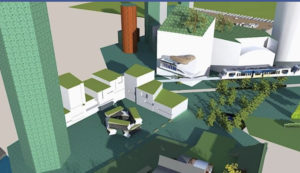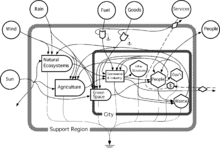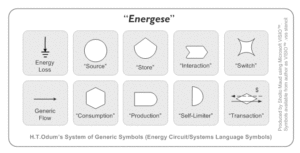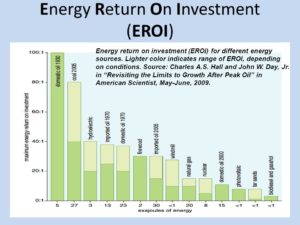[one_half]

Systems Planning
As a member of the Community Board, I, Cesar Yoc, have seen the piecemeal approach of design. I sit down and listen to presentations about the latest development project in the Mott Haven area of the South Bronx. As I sit there I go back to my Urban Planning studies and this idea I was developing called “Systems Planning”.
I have been thinking over the last year about how to define Systems Planning and identify elements that make up this idea of Systems Planning. I picture Systems Planning as a socioecological perspective of how cities can be understood or design. Using “Systems” as a method to connect ecological principles, urban planning principles, and laws of physics to understand and implement sustainable methods to manage and design cities.
[/one_half]
[one_half]
The book, Consilience: The Unity of Knowledge by E.O. Wilson helps in understanding how important it is to develop models of the physical environment and the psychological effects of design; using case studies to understand the reality of a space and the inputs required to maintain that reality. The Elements of Systems Planning were developed to understand complex human-dominated ecosystem. Systems Science also helps in understanding complex systems and to develop methods to solve complex problems.
The Institute uses the principles from the book Principles of Systems Science by George E. Mobus and Michael Kalton and is influenced by the work of Edward O. Wilson, Howard T. Odum, and Dr. Charles A.S. Hall. Consilience is a book that explains the importance of thinking holistically. The principles below are based on ideas from Edward O. Wilson, my experience living in the South, and my educational background in the sciences and urban planning. Some of these principles overlap and need further research.
[/one_half]
- In Systems Planning an urban space is a human-dominated ecosystem (urban areas, it is psychological driven by how we perceive our environment, our cultures, and our social norms (creativity, art, etc.)
- It follows the laws of thermodynamics, especially the second law (entropy): Archetype, how long does the building take to fall apart without the addition of energy? What is the energy potential of space?
- It is driven by natural resource availability
- It is both a close and open system based on how space is defined. Spatial Arrangement.
- It is a complex system that requires models to scratch the surface of its reality
- It is an adaptable and resilient, seeing the importance of this for the system to last longer. Pulsing System.
- It is driven by political norms or policy
- It knows that it can never be perfect that is malleable to change
- It sees other potentials of reality
- It maximizes its energy potential, mostly solar, through the placement of structures in ideal locations based on location potential research or ecosystem research
- It engineers a reality of oscillation and change
- It cannot be a law or applicable to every environment, it depends on defined space
- It requires the interaction of the natural world with the human world. That the system has environmental implications
- It balances species ecosystems
- It looks for a balance of bottom-up (grassroots) and top-down approach to planning and implementation
- It has to develop a set of tools that have short term and long term approaches to planning and designing cities
- It has energy focus zoning and focuses on multi-modal transportation options.
- Transportation for a variety of natural and human-dominated ecosystems.
- It uses ecological economics and biophysical economic principles to understand the economic implications of alternative solutions
[divider]
These are the twelve principles of Systems Science developed by George E. Mobus and Michael Kalton.
- Systemness
- Systems are processed organized in structural and functional hierarchies
- Systems are networks of relations among components and can be represented abstractly as such networks of relation
- Systems are dynamic over multiple spatial and time scales
- Systems exhibit various kinds and levels of complexity
- Systems evolve
- Systems encode knowledge and receive and send information
- Systems have regulatory subsystems and achieve stability
- Systems can contain models of other systems
- Sufficiently complex adaptive systems can contain models of themselves
- Systems can be understood
- Systems can be improved
[divider]
[one_half]
Emergy and Systems Ecology Diagrams
https://www.azimuthproject.org/azimuth/show/Systems+ecology


Howard T. Odum define Emergy (embody energy) as the amount of energy that was used to create something or a product. This is a method used to see the whole process of the product and how much energy is used and wasted throughout the process.
Energy Return on Investment
Developed by Dr. Charles Hall, Energy Return on Investment (EROI) is a ratio of the amount of energy (exergy) obtained from an energy resource to the amount of energy (exergy) expended to produce that energy.
https://www.investopedia.com/terms/e/energy-return-on-investment.asp#:~:text=Energy%20Return%20on%20Investment%20(EROI)%20is%20a%20ratio%20of%20the,expended%20to%20produce%20that%20energy.

[one_half]